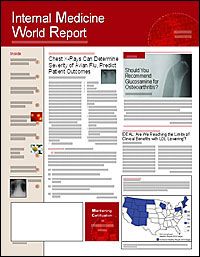Publication
Article
Internal Medicine World Report
Can Widespread Colorectal Cancer Screening Be Cost-Effective?
Author(s):
Screening for colorectal cancer is one of the most successful preventive care measures in modern medical practice. Beginning at age 50, men and women who are at average risk should undergo screening for colorectal cancer every 5 years. Persons at high risk should begin screening earlier and be screened more frequently.
There is little doubt about the benefits of colorectal cancer screening. There are, however, some questions about the ?cost-effectiveness of screening on a widespread basis. And while screening for colon cancer is becoming more common, it is still greatly underutilized.
A new study published in Gastro?enterology?(2005;129: 1151-1162) presents data showing that although widespread colon cancer screening would produce ?initial cost savings, if conventional tests were used, the increase in use would ?actually raise costs by as much as $0.8 billion to $2.8 billion annually after factoring in the care for newly diagnosed colorectal cancer patients.
Uri Ladabaum, MD, MS, of the Division of Gastroenterology, and Kenneth Song, MD, of the Department of Medicine, both of the University of California, San Francisco, used a decision analytic Markov model of the natural history of colon cancer in the United States to estimate the cost of screening 75% of the US population with both usual (ie, annual fecal occult blood testing [FOBT], flexible sigmoidoscopy [FS] every 5 years, FOBT/FS combined, and colonoscopy every 10 years) and emerging methods (ie, fecal DNA testing every 5 years and virtual colonoscopy every 10 years).
A steady state was as?sumed for population size and age, based on the most recent census data. Age-specific clinical mo?del outputs per patient and economic outputs were then established and adjusted to reflect the fraction of patients out of the original hypothetical co?hort who would still be alive at a certain age. Next, the investigators multiplied these age-specific models per patient by the number of patients at that age in the US population, again based on year 2000 census data. Results were corrected to represent a 75% screening uptake rate for each screening method.
Depending on the screening method, each patient gained about 0.045 to 0.063 discounted life-years, or 37 to 51 undiscounted life-days. Screening de?creased cancer incidence by 17% to 54% (dropping to as low as 66,000 cases annually) and mortality from colon cancer by 28% to 60% (as few as 23,000 deaths annually).
Total annual costs among colon cancer patients who did not undergo screening were $8.4 billion. Among patients who were screened, costs associated with cancer care were $1.5 billion to $4.4 billion, but this decrease was offset by the total expenditures associated with colon cancer screening, which amounted to from $9.2 billion to $15.4 billion.
Overall, total colo?n?oscopy use increased, even when it was as?sumed that there would be a considerable dem?and for virtual colon?oscopy. If three fourths of the population had a colon?oscopy every 10 years, 8.1 million colon?oscopies wo?uld be performed each year (in?cluding those for surveillance), meaning that every gastroenterologist would have to do 2 to 3 colonoscopies daily.
And although the costs of FOBT and fecal DNA testing were $4.2 billion and $8.9 billion annually, respectively, these figures jumped to $9.2 billion and $15.4 billion when total expenditures were factored in.
"Despite savings in colorectal cancer care, widespread screening is unlikely to be cost saving and may increase national expenditures by $0.8 billion to $2.8 billion per year with conventional tests," the investigators wrote.
This study addresses important questions being asked by physicians, public health planners, and policymakers, suggested the authors of an accompanying editorial (pages 1139-1341), Laura C. Seeff, MD, and Florence K. L. Tangka, PhD, both of the Division of Cancer Prevention and Control, Centers for Disease Control and Prevention, Atlanta, Ga. However, they added that screening for colon cancer is "an extremely dynamic area, and it may therefore be particularly difficult to make projections regarding colorectal cancer screening outcomes based solely on modeling efforts."
The editorialists suggested that additional questions must be answered before we can definitively establish the overall cost-effectiveness of widespread screening for colon cancer, including:
? Which of the currently recommended tests will become the most commonly recommended?
? How will the newer screening methods be received by physicians and patients?
? What impact will test costs and changing reimbursement rates have?
"Ultimately, as the authors suggest, real-world data is [sic] needed to truly understand the clinical costs and health care delivery outcomes of widespread screening," Drs Seeff and Tangka re?marked. "With careful planning, measurement of the capacity, and attention to test costs, it should be ?possible to design widespread cost-effective colorectal cancer screening programs that reduce colorectal cancer disease burden."






